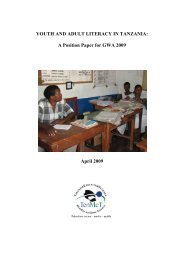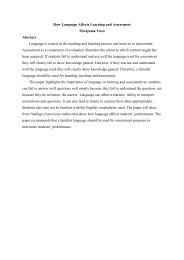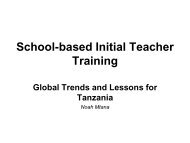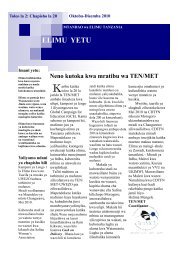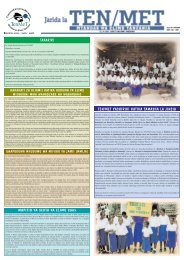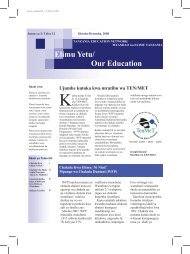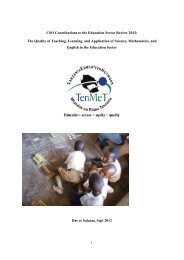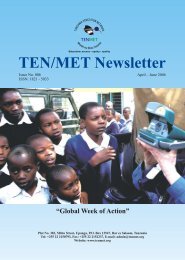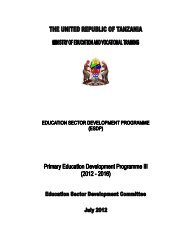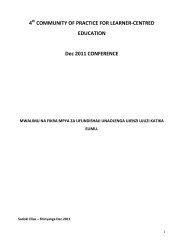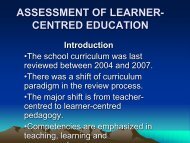A Simple Guide to Working with Finances in Education - Tanzania ...
A Simple Guide to Working with Finances in Education - Tanzania ...
A Simple Guide to Working with Finances in Education - Tanzania ...
Create successful ePaper yourself
Turn your PDF publications into a flip-book with our unique Google optimized e-Paper software.
4.3.4 Public Expenditure Reviews (PERs)Thes are carrried out as a way of provid<strong>in</strong>g the analytical basis for budget reform. PERsare based on the same basic assumptions as PRSPs. PERs look at the previous year’sspend<strong>in</strong>g, <strong>to</strong> evaluate whether poor people benefit from exist<strong>in</strong>g spend<strong>in</strong>g patterns andwhat outcomes are be<strong>in</strong>g achieved. They make recommendations on cutt<strong>in</strong>g or shift<strong>in</strong>gspend<strong>in</strong>g <strong>with</strong><strong>in</strong> sec<strong>to</strong>rs. There is also concern <strong>to</strong> ensure that spend<strong>in</strong>g is cost effective,is equitable, and doesn’t spend government money where the private sec<strong>to</strong>r couldoperate. PER recommendations may re-appear as conditions/benchmarks <strong>in</strong> Bank andFund loans. Each sec<strong>to</strong>r has a PER which contributes <strong>to</strong> the overall national PER.The purpose of the education PER is <strong>to</strong> evaluate the previous year’s spend<strong>in</strong>g <strong>in</strong> theeducation sec<strong>to</strong>r - whether it was <strong>in</strong> l<strong>in</strong>e <strong>with</strong> plans, and whether by keep<strong>in</strong>g <strong>to</strong> the plans,the desired outcomes are likely <strong>to</strong> be achieved. This means look<strong>in</strong>g at the <strong>in</strong>puts (such asfor education, pr<strong>in</strong>cipally money from government and donor resources), the processes(whether the money was properly spent and accounted for), the outputs (teachersemployed, classrooms built), and, ultimately, outcomes (such as a more conducivelearn<strong>in</strong>g environment for pupils). With a focus on poverty, the <strong>in</strong>terest is not just on thelearn<strong>in</strong>g environment as an end <strong>in</strong> itself, but beyond that <strong>to</strong> whether the education systemas a whole is play<strong>in</strong>g its part <strong>in</strong> break<strong>in</strong>g the cycle of poverty and vulnerability.The PER process specifically looks for CSO <strong>in</strong>put <strong>in</strong> assess<strong>in</strong>g the effectiveness ofspend<strong>in</strong>g, and there is CSO <strong>in</strong>volvement <strong>in</strong> the relevant work<strong>in</strong>g groups <strong>to</strong> this end.An up-<strong>to</strong>-date list of the NGOs <strong>in</strong>volved <strong>in</strong> <strong>Tanzania</strong> can be obta<strong>in</strong>ed from TEN/MET.4.3.5 The Medium Term Expenditure Framework (MTEF)This process allocates government and donor resources between compet<strong>in</strong>g priorities.MTEF establishes a 3 years roll<strong>in</strong>g budget focused on activities and outputs <strong>in</strong> l<strong>in</strong>e <strong>with</strong>priorities emerg<strong>in</strong>g from the Poverty Reduction Strategy (and PER), Roll<strong>in</strong>g means thateach year it is adjusted <strong>to</strong> take account of what happened <strong>in</strong> the first year of theprevious MTEF, creat<strong>in</strong>g a new three year plan.The MTEF tries <strong>to</strong> br<strong>in</strong>g <strong>to</strong>gether the amount of resources, which are likely <strong>to</strong> beavailable (<strong>with</strong>out caus<strong>in</strong>g macro-economics problems, like high <strong>in</strong>flation) <strong>with</strong> abot<strong>to</strong>m up estimate of the current and medium term costs of carry<strong>in</strong>g out nationalpriorities as def<strong>in</strong>ed <strong>in</strong> the PRS. Each year there is a back and forth process of agree<strong>in</strong>gthe budget by look<strong>in</strong>g at the resource constra<strong>in</strong>ts and the spend<strong>in</strong>g needs, through theissu<strong>in</strong>g of budget guidel<strong>in</strong>es (see the <strong>in</strong>formation on the budget cycle).The MTEF and PER are meant <strong>to</strong> help the M<strong>in</strong>istry of F<strong>in</strong>ance get away from mak<strong>in</strong>garbitrary cuts on, for example, the education budget, by mak<strong>in</strong>g the educationplanners look very carefully at how they are spend<strong>in</strong>g the resources, and close downany areas of work which are not <strong>in</strong> l<strong>in</strong>e <strong>with</strong> priorities.20



